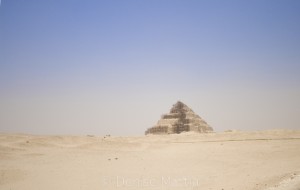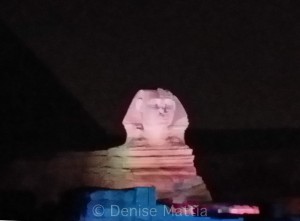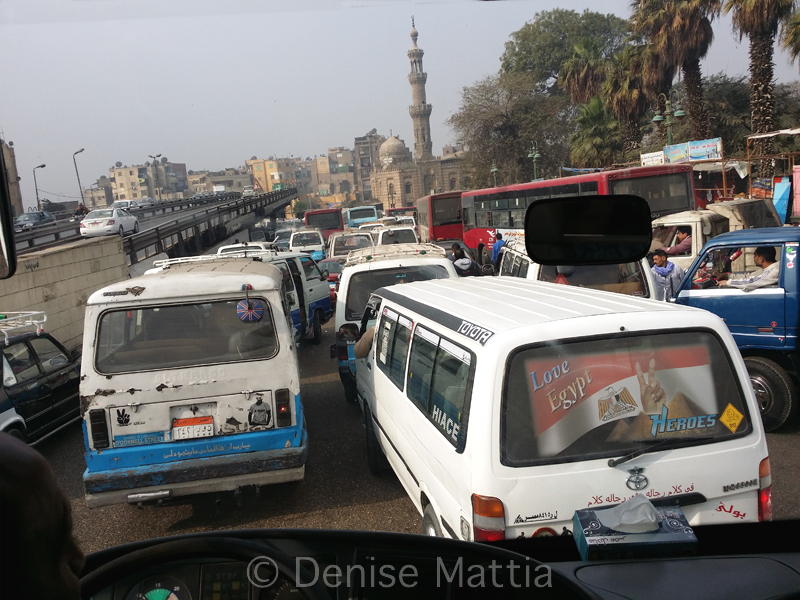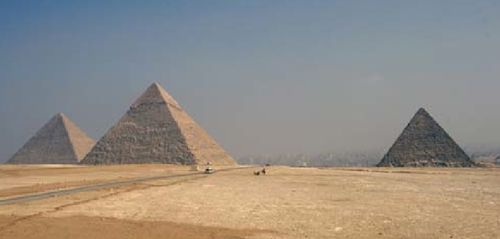By Denise Mattia
A busload of tourists was on its way to the Sound and Light Show at the Pyramids in Giza, Egypt. Sitting among them in the third row, I wondered how long it would take to get there. We’d left the Cairo Marriott Hotel and Omar Khayya Casino on Gezirah Island in plenty of time before the performance. Still, as the bus inched its way across the 26 July Bridge, I noticed there weren’t traffic lights or traffic officers in the city that evening (or ever, I thought). Cars converge to and from two-way streets, drivers shift from one lane to another and then back again, mindless that their vehicles have lane-signaling lights. Without making eye contact, pedestrians amble across streets through traffic without incident.
For the first time in over a century Cairo had experienced snow that winter and the chilly temps lingered. Clinging to winter coats, our group took a guided tour of the Lower Nile, the northern-most region of Egypt along the bank of the River. The spectacular Sakkara complex and the step pyramid were shrouded in a scrim of mist that almost obscured them. Further obscured by scaffolding the king’s terrestrial residence is undergoing preservation. Fog and scaffolding not withstanding, we stood and gazed speechlessly in wonderment at the size and ingenuity of the builders designed to last an eternity 4,500 years ago by architect and god, Imhotep.
 The sun appeared and seemed to light up the massive pyramids of Kings Cheops, Chephren and Mycerinus at Giza. Lying southwest at exactly a prolonged diagonal to each other, the Chephren and Cheops pyramids are approximately the same height, although the distance between the two makes the latter look smaller. At the top the vestiges of the original façade of the Chephren Pyramid remain. Near the center is an entrance – the way out toward the fixed stars of the northern sky – to the north. To the southeast are three smaller pyramids built for queens. The colossal Great Sphinx – the enigmatic combination of lion and king — lies a short distance away. Whether the embodiment of power and spirit, the guardian of the necropolis or a symbol of resurrection and reawakening, the Sphinx is one of the great ancient wonders of the world. The cultural and historical significance at the Sound and Light show that evening would augment what we’d learned that morning.
The sun appeared and seemed to light up the massive pyramids of Kings Cheops, Chephren and Mycerinus at Giza. Lying southwest at exactly a prolonged diagonal to each other, the Chephren and Cheops pyramids are approximately the same height, although the distance between the two makes the latter look smaller. At the top the vestiges of the original façade of the Chephren Pyramid remain. Near the center is an entrance – the way out toward the fixed stars of the northern sky – to the north. To the southeast are three smaller pyramids built for queens. The colossal Great Sphinx – the enigmatic combination of lion and king — lies a short distance away. Whether the embodiment of power and spirit, the guardian of the necropolis or a symbol of resurrection and reawakening, the Sphinx is one of the great ancient wonders of the world. The cultural and historical significance at the Sound and Light show that evening would augment what we’d learned that morning.
But trucks, busses, cars and tuk tuks converged at corners, and it soon became clear that we’d not get to the Pyramids at Giza in time. The road that leads to the ancient city was closed due to construction, which forced our bus driver to snake through a maze of narrow streets. If this had been a Friday (the Muslim holy day), traffic would have been light, but it was midweek and, as usual, Egyptians and visitors were out in droves.
Cairo is the largest city in the Middle East and Africa, with 7.7 million inhabitants, and there are 20 cars for every 100 people (children excluded). It appeared as though every vehicle and tour bus was in use that night.
In the single-lane street a din arose from people on sidewalks shouting and laughing, from a parade of various makes and models of autos revving and drivers vying for space.
In an effort to blaze a pathway, Karim Ala from our group got out of the bus and squeezed himself in the midst of vehicles and became a self-appointed director of traffic. Boys, mostly teenagers who’d been watching the performance joined in, adding to Karim’s efforts. Is the country safe? The fact that anyone of us would have done what Karim did is proof that it is.
Meanwhile Alexandra Heemskerk who’d been sitting in the front seat of our bus, stood with the microphone and delivered a commentary of progress for those members sitting in the rear who were unable to witness the performance. After 40 minutes at nearly a standstill in traffic the bus passed the bottleneck and we sped to Giza on the west bank of the Nile River.
 Seeing the Pyramids and the Sphinx illuminated at night was worth the travel time. The show takes viewers from the Old Kingdom when Egypt was one of the richest and most powerful civilizations in the world to the Ptolemaic period in the fourth century A.C.E., when finally, the kingdom and strong central government virtually collapsed.
Seeing the Pyramids and the Sphinx illuminated at night was worth the travel time. The show takes viewers from the Old Kingdom when Egypt was one of the richest and most powerful civilizations in the world to the Ptolemaic period in the fourth century A.C.E., when finally, the kingdom and strong central government virtually collapsed.
We gained a further knowledge about Egypt, not only in having seen the Pyramids and the Sound and Light Show, but also by having witnessed the behavior of how an age-old civilization handles a modern-day situation. When freedom was at stake, the country erupted, but when situations are unavoidable, like a traffic jam (or a crowded market), the Egyptians’ sense of humor and camaraderie is the mark of a true civilization.
About Denise Mattia
A writer and photographer, Denise Mattia’s works are published nationally and internationally and include all aspects of leisure travel: art , culture, resorts, spas, food and wine and sports’ activities. She's the founder of the soon to be launched Yum-Yum-Traveler, a site devoted to reviewing restaurants in addition to her travel articles from around the world. She lives and works in Manhattan, where she was born.
- Web |
- More Posts (91)


